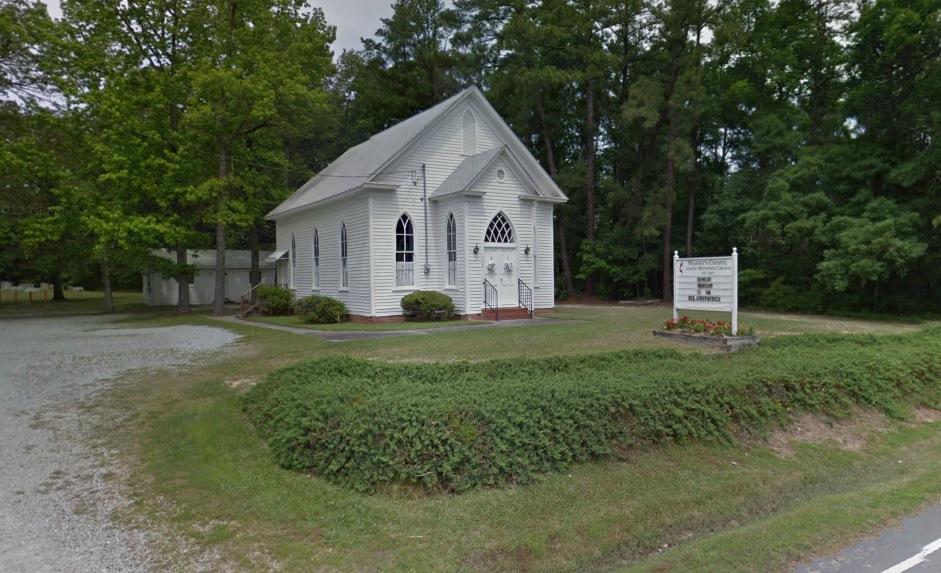Located right around the corner from Southpoint Mall, the current Massey's Chapel building has hosted its United Methodist congregation for the over a century. The simple and elegant wooden structure is designed proportionally around its stock Gothic windows. Besides replacements and repairs done to the walls, the exterior of the building is very nearly in its original form and the interior spaces are all original.
Much of the early history of the Massey Chapel congregation is captured in Rev. F.B. Jackson’s “The History of Massey’s Chapel Methodist Episcopal Church, South, to 1931”, originally written to be delivered as a lecture and later published as a pamphlet. Much of Jackson’s narrative relies on the recollections of Pleasant H. Massey, a church member for more than 50 years who is buried in the cemetery behind the chapel.
The Massey Chapel church congregation was founded in 1855. A roll dated September 14, 1856 lists John Massey, Elizabeth R. Massey, Emily K. Massey, Tempy Cates, and Catherine Herndon as present, all presumably early or even founding members of the congregation.
John and Elizabeth Massey were married, Emily their daughter. The Masseys were farmers and the extended Massey family owned a great deal of land in the vicinity of the chapel. Pleasant H. Massey was the son of John and Elizabeth.
Catherine Herndon, around twelve at the time, was a member of the neighboring Herndon family who owned much land to the east of the Masseys.
The identity of Tempy (possibly short for Temperance) Cates is more of a mystery and cannot be easily linked to any one person on the census rolls. There is a strong possibility that she was associated with the Cates family of Hillsborough.
Church oral history tradition states that one of the original church members was a black woman. It is possible that Tempy Cates may have been that woman but no records can confirm this. Even if she was white it is still feasible that the church tradition is true and the black woman was simply not accounted for in any material records. Further, while it is possible the black member may have been free, given that the congregation was located in the middle of nowhere at the time (there was no Southpoint or Fairfield subdivision, Durham had not even been incorporated as a town yet), it is most likely she was enslaved — either by the Masseys or by another slave owner from whom the Massey’s hired her.
“When it was decided to build Massey’s Chapel Church there was no one in sight who could give any material aid except John Massey. He was a poor farmer and had about as much as he thought he could do to maintain his family and live,” the Jackson text reads. Pleasant Trice, “a wealthy slave owner,” gave $25 to Massey to build the church which he constructed on his own land.
In the early years, the congregation met once a month and only on weekdays, never Sundays.
Due to/with the help of the chapel’s growth in membership, the present structure was constructed in 1900.
Annie King, a member of the church her entire life, is largely credited with helping the church gain landmark status from Durham County in 1989, the first property to receive such designation. At 101 years old, King participated in the reveal of the historic plaque placed upon Massey’s Chapel in April 2017. Preservation Durham contributed assistance in the application for a plaque.
Congregation members credit the chapel’s historic landmark designation as a tool through which the property has resisted development pressure in recent years.
(The information below in italics is from the Historic Preservation Society of Durham Plaque Application for Massey's Chapel)
The best source of information about the early days of Massey's Chapel is "The History of Massey's Chapel Methodist Episcopal Church, South, to 1931" by the Reverend F. B. Jackson in 1931. Jackson's history relies primarily upon the recollections of Pleasant H. Massey who had for many years been one of the mainstays of the church. Jackson's history was written to be delivered as a lecture to the congregation and was later published in pamphlet form. See copy attached. This document contains a wealth of information, but is unfortunately soft on the dates of events.
Jackson records that the church was founded in 1855 by John Massey, Elizabeth R. Massey, Emily K. Massey, Tempy Cates, and Catherine Herndon. United States Census records for 1850 indicate that Elizabeth Massey was John Massey's wife. According to the census, John was 39 years old in 1850. His grave marker in the cemetery behind the chapel indicates, however, that John Hardy Massey was born in 1807 and that he died in 1882. The census records indicate that Elizabeth was 28 in 1850, but her grave marker indicates that she was born in 1820. She died in 1901. Emily Massey was John and Elizabeth Massey's daughter. In 1855, she would have been around twelve years old. The Masseys were farmers and the extended Massey family owned a great deal of land in the vicinity of the chapel. Catherine Herndon was only about twelve or thirteen years old when her name was placed on the roll in 1855. The Herndons were neighbors of the Masseys with significant land holdings of their own to the east. The identity of Tempy Cates is a mystery. The problem is that Tempy is likely not a proper name (It may be short for Temperance). There was (and still is) a large Cates family in Hillsborough which was the county seat at the time the chapel was founded. Tempy may have been a member of that family (there were several possibilities in the census records) who was visiting with friends in the Massey family when the roll was first created, but this merely conjecture.
It is part of the church's oral tradition that one of the original church members was a person of color. It is possible that Tempy Cates was that person, but a search of available records cannot confirm this. Even if Tempy Cates was white, the absence from the recollections of Pleasant Massey of the name of another or other persons who may have been present at the original meetings of the church does not mean that the church's tradition is not true.
The Jackson history lays down a sequence of events and identifies important persons associated with the chapel. It establishes that in the early years John Massey built a church building presumably on his own land with financial assistance from neighbors. Jackson does not identify when the church became an entity independent of Massey ownership. At some point in time, however, the church did become independent although the Massey family remained very much involved in the life and government of the church.
The present building is believed to have been erected around 1900. Charles and Pleasant Massey counted among the many children of John and Elizabeth Massey. Pleasant Hardy Massey was born in 1853 and died in 1941. He is buried in the cemetery behind the church. Charles Wesley Massey was born in 1858 and died in 1938. He is buried in Maplewood Cemetery in Durham. Jackson's history informs us that Pleasant Massey was the pastor of the church and that Charles was the Sunday school superintendent when the current church building was built. At that time, a Mr. J. W. Elliott also appears to have been important in the life of the church. Both Pleasant Massey and Mr. Elliott were trustees of the independent church when Virginia Massey sold the church the parcel described in the 1918 deed.
In 1989, Durham County, acting upon an application prepared largely by Annie King, a long-time member of the Massey's Chapel congregation, granted the church landmark status pursuant to N.C.G.S 160A-399. It was the first property in Durham County to be so recognized. Copies of the resolution of the Board of County Commissioners, the county's landmark certificate and the letter transmitting it, and the letter from the North Carolina Department of Cultural Resources concurring with the designation of the church as a landmark are attached to this application...
...The only material changes made to the property since the staff's inspection in 1989 have been the replacement of the concrete sidewalks and the addition of a steel handicap access ramp to the south side of the building. This ramp gives access to the stoop serving the door at the rear of the church on the south side. The ramp rests on the stoop but is not permanently affixed to the church building itself and does not significantly impact the historic integrity of the building.
A recent interview with church members indicates that the church building originally rested upon small brick piers at the corners and rubble stone piers elsewhere. By the 1980s, the mortar holding the stone piers together had failed and some of the piers, especially on the north side of the building, had collapsed allowing the building to rest on the ground. The congregation responded by jacking the church up and replacing the original stone piers with a brick perimeter foundation. At that time some decayed parts of the wooden structure were replaced or repaired. These same church members also advised that the original bead-board wall covering inside the church is present beneath the laminate paneling added in the late 1960s or early 1970s when the interior of the building was remodeled.
The building is designed proportionately around its stock gothic windows. The effect is elegant in its simplicity. The exterior of the building is very nearly in its original form and the interior spaces are all original even though the walls have been covered and a drop paneled ceiling has been added.


Add new comment
Log in or register to post comments.